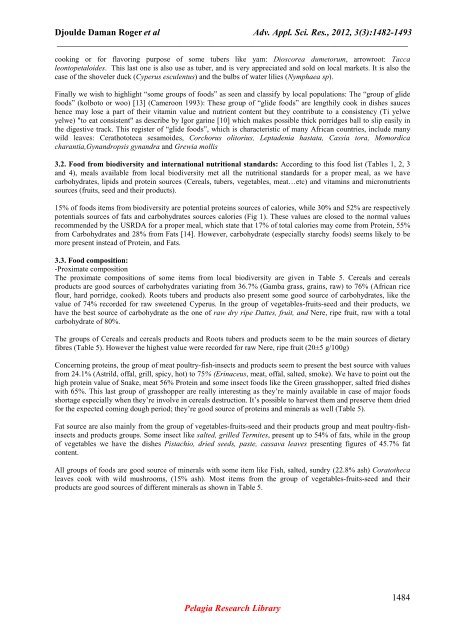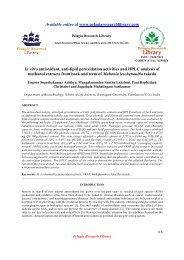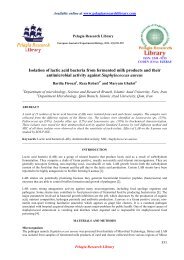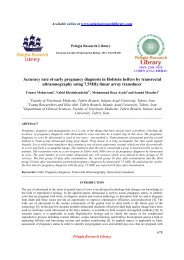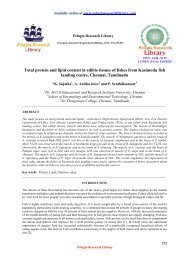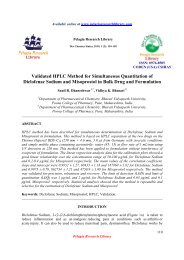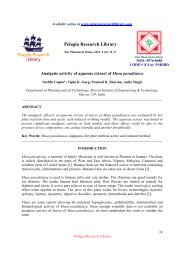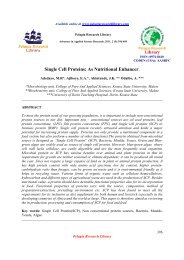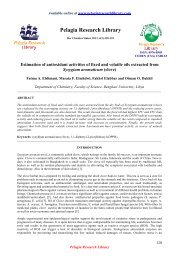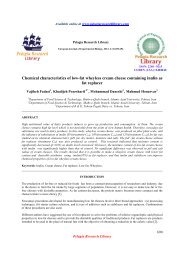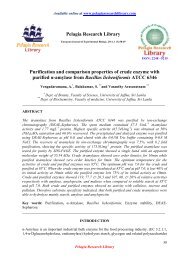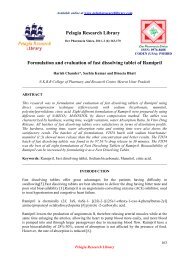Nutritional properties of “Bush Meals” - Pelagia Research Library
Nutritional properties of “Bush Meals” - Pelagia Research Library
Nutritional properties of “Bush Meals” - Pelagia Research Library
Create successful ePaper yourself
Turn your PDF publications into a flip-book with our unique Google optimized e-Paper software.
Djoulde Daman Roger et al Adv. Appl. Sci. Res., 2012, 3(3):1482-1493<br />
_____________________________________________________________________________<br />
cooking or for flavoring purpose <strong>of</strong> some tubers like yam: Dioscorea dumetorum, arrowroot: Tacca<br />
leontopetaloides. This last one is also use as tuber, and is very appreciated and sold on local markets. It is also the<br />
case <strong>of</strong> the shoveler duck (Cyperus esculentus) and the bulbs <strong>of</strong> water lilies (Nymphaea sp).<br />
Finally we wish to highlight “some groups <strong>of</strong> foods” as seen and classify by local populations: The “group <strong>of</strong> glide<br />
foods” (kolboto or woo) [13] (Cameroon 1993): These group <strong>of</strong> “glide foods” are lengthily cook in dishes sauces<br />
hence may lose a part <strong>of</strong> their vitamin value and nutrient content but they contribute to a consistency (Ti yelwe<br />
yelwe) "to eat consistent" as describe by Igor garine [10] which makes possible thick porridges ball to slip easily in<br />
the digestive track. This register <strong>of</strong> “glide foods”, which is characteristic <strong>of</strong> many African countries, include many<br />
wild leaves: Cerathototeca sesamoides, Corchorus olitorius, Leptadenia hastata, Cassia tora, Momordica<br />
charantia,Gynandropsis gynandra and Grewia mollis<br />
3.2. Food from biodiversity and international nutritional standards: According to this food list (Tables 1, 2, 3<br />
and 4), meals available from local biodiversity met all the nutritional standards for a proper meal, as we have<br />
carbohydrates, lipids and protein sources (Cereals, tubers, vegetables, meat…etc) and vitamins and micronutrients<br />
sources (fruits, seed and their products).<br />
15% <strong>of</strong> foods items from biodiversity are potential proteins sources <strong>of</strong> calories, while 30% and 52% are respectively<br />
potentials sources <strong>of</strong> fats and carbohydrates sources calories (Fig 1). These values are closed to the normal values<br />
recommended by the USRDA for a proper meal, which state that 17% <strong>of</strong> total calories may come from Protein, 55%<br />
from Carbohydrates and 28% from Fats [14]. However, carbohydrate (especially starchy foods) seems likely to be<br />
more present instead <strong>of</strong> Protein, and Fats.<br />
3.3. Food composition:<br />
-Proximate composition<br />
The proximate compositions <strong>of</strong> some items from local biodiversity are given in Table 5. Cereals and cereals<br />
products are good sources <strong>of</strong> carbohydrates variating from 36.7% (Gamba grass, grains, raw) to 76% (African rice<br />
flour, hard porridge, cooked). Roots tubers and products also present some good source <strong>of</strong> carbohydrates, like the<br />
value <strong>of</strong> 74% recorded for raw sweetened Cyperus. In the group <strong>of</strong> vegetables-fruits-seed and their products, we<br />
have the best source <strong>of</strong> carbohydrate as the one <strong>of</strong> raw dry ripe Dattes, fruit, and Nere, ripe fruit, raw with a total<br />
carbohydrate <strong>of</strong> 80%.<br />
The groups <strong>of</strong> Cereals and cereals products and Roots tubers and products seem to be the main sources <strong>of</strong> dietary<br />
fibres (Table 5). However the highest value were recorded for raw Nere, ripe fruit (20±5 g/100g)<br />
Concerning proteins, the group <strong>of</strong> meat poultry-fish-insects and products seem to present the best source with values<br />
from 24.1% (Astrild, <strong>of</strong>fal, grill, spicy, hot) to 75% (Erinaceus, meat, <strong>of</strong>fal, salted, smoke). We have to point out the<br />
high protein value <strong>of</strong> Snake, meat 56% Protein and some insect foods like the Green grasshopper, salted fried dishes<br />
with 65%. This last group <strong>of</strong> grasshopper are really interesting as they’re mainly available in case <strong>of</strong> major foods<br />
shortage especially when they’re involve in cereals destruction. It’s possible to harvest them and preserve them dried<br />
for the expected coming dough period; they’re good source <strong>of</strong> proteins and minerals as well (Table 5).<br />
Fat source are also mainly from the group <strong>of</strong> vegetables-fruits-seed and their products group and meat poultry-fishinsects<br />
and products groups. Some insect like salted, grilled Termites, present up to 54% <strong>of</strong> fats, while in the group<br />
<strong>of</strong> vegetables we have the dishes Pistachio, dried seeds, paste, cassava leaves presenting figures <strong>of</strong> 45.7% fat<br />
content.<br />
All groups <strong>of</strong> foods are good source <strong>of</strong> minerals with some item like Fish, salted, sundry (22.8% ash) Coratotheca<br />
leaves cook with wild mushrooms, (15% ash). Most items from the group <strong>of</strong> vegetables-fruits-seed and their<br />
products are good sources <strong>of</strong> different minerals as shown in Table 5.<br />
<strong>Pelagia</strong> <strong>Research</strong> <strong>Library</strong><br />
1484


